Content #1
Content #1
Content #1
This unique reagent quenches lipofuscin autofluorescence in tissue sections for immunofluorescence staining and can also help to reduce autofluorescence from other sources like extracellular matrix.
TrueBlack® Lipofuscin Autofluorescence Quencher is a novel reagent that quenches lipofuscin autofluorescence in tissue sections for immunofluorescence staining.
TrueBlack® effectively eliminates lipofuscin autofluorescence in tissues like human and mouse brain and retina (see Figs. 1-3 and TrueBlack® References). Lipofuscin consists of highly autofluorescent granules of oxidized proteins and lipids that build up in the lysosomes of aging cells. Lipofuscin granules fluoresce brightly in all channels used for fluorescence microscopy, and accumulate in a variety of cell and tissue types with age. Consequently, imaging of specific immunofluorescence signal in certain adult human tissues or aged animal tissues can be virtually impossible unless methods are employed to quench or mask lipofuscin fluorescence.
Note: TrueBlack® Lipofuscin Autofluorescence Quencher, 20X in DMF (Cat. No. 23007) is the original formulation. TrueBlack® Lipofuscin Autofluorescence Quencher, 30X in DMSO (Cat. No. 23011) is a newer, more concentrated formulation in DMSO, which is a less toxic solvent than DMF. The quencher stock solution formulation does not affect the performance in staining.
Traditionally, Sudan Black B has been used to quench lipofuscin autofluorescence by incubating tissue sections with the dye after immunofluorescence staining. However, while it masks the autofluorescence from lipofuscin, Sudan Black B also introduces uniform non-specific background fluorescence in the red and far-red channels (Fig. 1), limiting the use of fluorescent dyes in those wavelengths. Now Biotium has developed TrueBlack® as a superior alternative to Sudan Black B. TrueBlack® quenches lipofuscin fluorescence with far less increase in red/far-red background fluorescence (Fig. 1). TrueBlack® treatment can be performed before or after immunostaining. It is rapid, simple, and has minimal effect on signal from fluorescent antibodies or nuclear counterstains, thus preserving the signal-to-noise ratio of the immunostaining (Figs. 2-3).
TrueBlack® also can reduce autofluorescence from other sources, such as collagen, elastin, red blood cells, and general background fluorescence. It is not as effective at quenching these sources of autofluorescence as it is for lipofuscin, but it can improve background in human and non-human tissue types (Figs. 4-5). TrueBlack® also has been used to quench background fluorescence on polycarbonate filters used as cell supports for imaging cytometry.
TrueBlack® Lipofuscin Autofluorescence Quencher belongs to our TrueBlack® line of background reducing agents for fluorescence applications, which includes TrueBlack® WB Blocking Buffer Kit for western blotting, and TrueBlack® IF Background Suppressor System (Permeabilizing) for blocking non-specific immunofluorescence staining. Also see our other accessory products for immunofluorescence staining and other applications.
Biotium has also developed TrueBlack® Plus (catalog no. 23014), a next-generation lipofuscin quencher that offers even lower far-red background than the original TrueBlack® (catalog no. 23007). TrueBlack® Plus is also the only lipofuscin quencher that can be used in aqueous buffer instead of 70% EtOH, allowing longer incubation times for thick tissue samples without shrinkage.
TrueBlack® quenches lipofuscin with less background than Sudan Black B
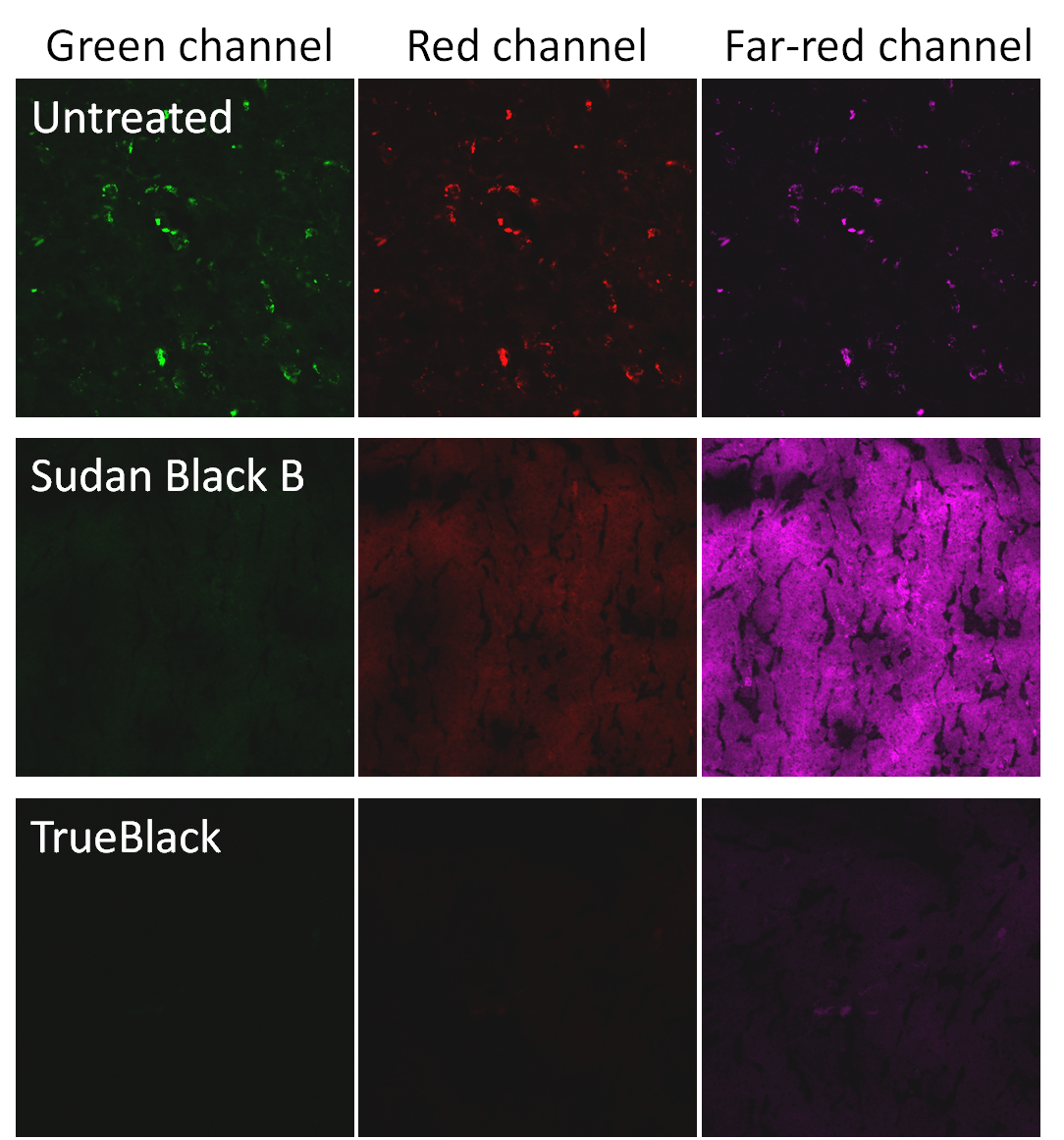
Figure 1. Lipofuscin autofluorescence in methanol-fixed adult human brain sections. In untreated tissue (top row), lipofuscin appeared as fluorescent granules that fluoresced in all fluorescence channels. Sudan Black B (middle row) masked lipofuscin autofluorescence, but introduced background in the red and far-red channels. TrueBlack® (bottom row) masked lipofuscin with minimal increase in fluorescence background (bottom row). Methanol-fixed cryosections of adult human cerebral cortex were left untreated or stained with 0.1% Sudan Black B in 70% ethanol or 1X TrueBlack® according to product protocol. Samples were imaged at the same gain settings on a Zeiss LSM 700 confocal microscope in the FITC (green), Cy®3 (red), and Cy®5 (far-red) channels.
TrueBlack® treatment can be performed before or after immunofluorescence staining
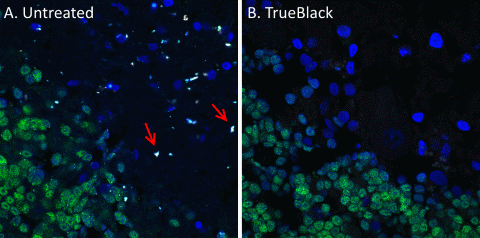
Figure 2. Quenching of lipofuscin autofluorescence using TrueBlack® pretreatment before immunofluorescence staining. Formaldehyde-fixed human cortex cryosections were left untreated (A) or treated with TrueBlack® (B), then stained with CF®488A anti-NeuN antibody conjugate (green) and DAPI (blue). Sections were imaged in all channels on a Zeiss LSM700 confocal microscope. A. Lipofuscin fluoresces brightly in all channels, appearing as white spots (red arrows) in the merged image of untreated tissue. B. TrueBlack® pretreatment eliminated lipofuscin autofluorescence, with negligible effect on specific staining.
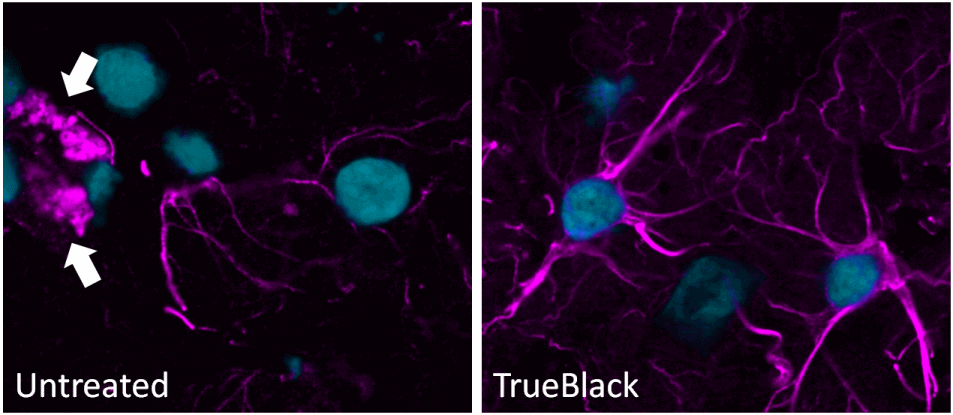
Figure 3. Quenching of lipofuscin autofluorescence using TrueBlack® post-treatment after immunofluorescence staining. Methanol-fixed cryosections of human cerebral cortex were stained with rabbit anti-GFAP followed by CF®640R goat anti-rabbit (cat. no. 20176) and DAPI (cat. no. 40009). Sections were left untreated or treated with TrueBlack®, then mounted in EverBrite mounting medium (cat. no. 23001). Untreated sections (left) showed lipofuscin autofluorescence (white arrows) in addition to GFAP immunofluorescence (glial processes, magenta) and DAPI staining (nuclei, blue). TrueBlack® (right) eliminated lipofuscin fluorescence while maintaining good signal-to-noise for GFAP immunostaining in the far-red channel (magenta) and nuclear counterstaining (blue).
TrueBlack® can reduce autofluorescence from sources other than lipofuscin
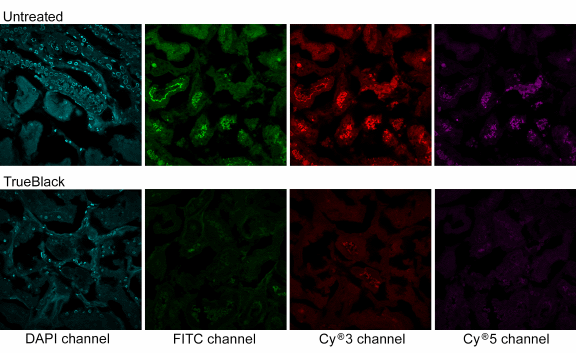
Figure 4. TrueBlack® reduces non-lipofuscin autofluorescence in human kidney sections in the FITC, Cy®3, and Cy®5 channels. Human kidney cryosections were fixed in ice-cold methanol and nuclei were stained with DAPI (blue). Autofluorescence was imaged on a Zeiss LSM 700 confocal microscope in all channels with the same imaging settings for both samples.Top panel: untreated; Bottom panel: TrueBlack®-treated.
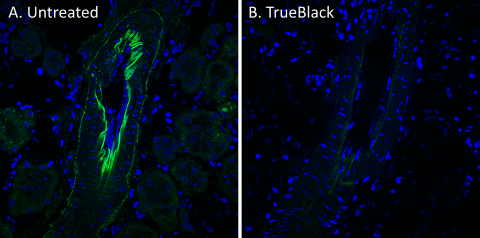
Figure 5. TrueBlack® reduces non-lipofuscin autofluorescence in the FITC channel in rat kidney tissue sections. Rat kidney cryosections were fixed in formaldehyde, and left untreated (A) or treated with TrueBlack® (B). Nuclei were stained with DAPI (blue). Autofluorescence in the FITC channel (green) was imaged on a Zeiss LSM700 confocal microscope using the same imaging settings for each sample.
| Product | Catalog No. | Supplied as | Notes |
|---|---|---|---|
| TrueBlack® Lipofuscin Autofluorescence Quencher, 20X in DMF | 23007 | 20X in DMF | • Original formulation |
| TrueBlack® Lipofuscin Autofluorescence Quencher, 30X in DMSO | 23011 | 30X in DMSO | • More concentrated formulation in DMSO • Less toxic solvent than DMF |
Download curated list of TrueBlack® References
Download curated list of TrueBlack® References
TrueBlack® Lipofuscin Autofluorescence Quencher, 20X in DMF (Cat. No. 23007) is the original formulation. TrueBlack® Lipofuscin Autofluorescence Quencher, 30X in DMSO (Cat. No. 23011) is a newer, more concentrated formulation in DMSO, which is a less toxic solvent than DMF. The quencher stock solution formulation does not affect the performance in staining.
TrueBlack® Lipofuscin Autofluorescence Quencher and TrueBlack® Plus Lipofuscin Autofluorescence Quencher were not designed for colorimetric detection, but they will stain lipofuscin black and be visible in light microscopy.
TrueBlack® Lipofuscin Autofluorescence Quencher (Cat. No. 23007, 23011) and TrueBlack® Plus Lipofuscin Autofluorescence Quencher (Cat. No. 23014) are designed to reduce autofluorescence from lipofuscin in tissue samples such as mouse and human brains and retina. While TrueBlack® Lipofuscin Quenchers have been reported to reduce autofluorescence from other sources, such as collagen, elastin, red blood cells, and general background fluorescence, they are not as effective at quenching these types of autofluorescence as for lipofuscin autofluorescence. However, they may improve background from a variety of sources in different experimental systems.
TrueBlack® IF Background Suppressor System (Cat. No. 230120) is a buffer system designed for optimal blocking of non-specific antibody binding as well as direct interaction of fluorescent dyes on antibodies with cells or tissue sections to eliminate non-specific staining for immunofluorescence (IF).
The TrueBlack® WB Blocking Buffer Kit (Cat. No. 23013) is a ready-to-use buffer system for blocking non-specific interactions of dye-labeled antibodies with proteins and the blotting membrane in fluorescence-based western blotting (WB).